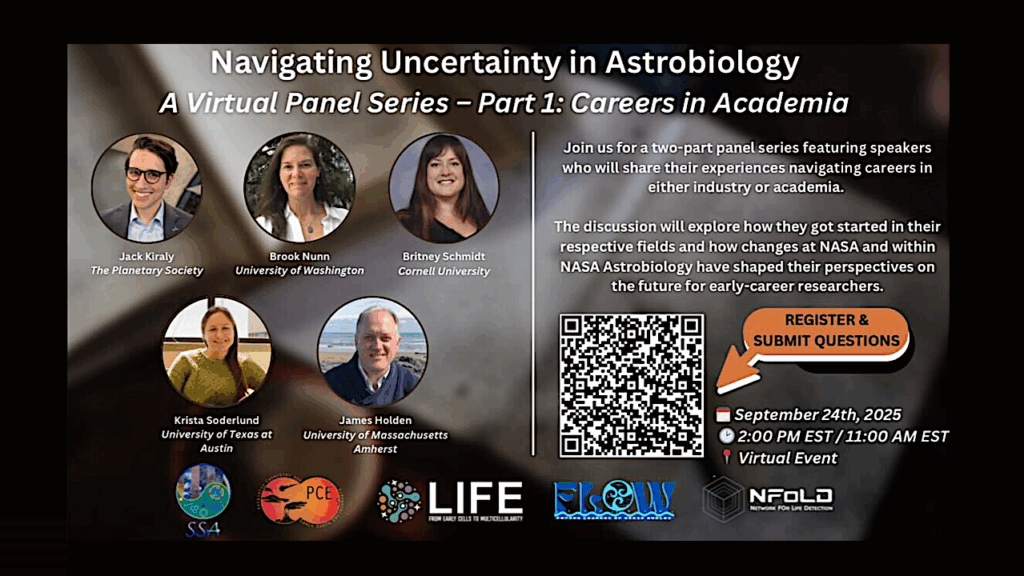NAI Announces Selection of New Teams
Please join the NAI in welcoming five new research teams into the Institute–the University of Washington; Massachusetts Institute of Technology; the University of Wisconsin, Madison; the University of Illinois, Urbana-Champaign; and the University of Southern California.
“The intellectual scope of astrobiology is breathtaking, from understanding how our planet went from lifeless to living, to understanding how life has adapted to Earth’s harshest environments, to exploring other worlds with the most advanced technologies to search for signs of life,” said Carl Pilcher, Director of the NAI. “The new teams cover that breadth of astrobiology, and by coming together in the NAI, they will make the connections between disciplines and organizations that stimulate fundamental scientific advances.”
“How would we know if an extrasolar planet were able to support life or had life on it already?” asks the University of Washington’s Virtual Planetary Laboratory (VPL) team, led by Victoria Meadows. Using interdisciplinary computational models, VPL examines life’s observable impact on a planetary environment, considering a variety of metabolisms, planetary compositions, and host stars. The result of this team effort will be a library of astronomical biosignatures against which spectral and photometric data returned by missions such as JWST can be cross-referenced to check for signs of life.
The Massachusetts Institute of Technology team led by Roger Summons asks, “If we cannot detect complex life on Earth when it first arose, how can we hope to detect life on other planets?” This team examines the history of complex life by studying Earth’s rock record, particularly fossil, isotopic, and molecular evidence. Its focus is taphonomy–the combination of processes and conditions that preserve biological signatures. The team uses the insights it develops to guide how and where to look for evidence for life elsewhere, particularly at Gale Crater on Mars, site of the Curiosity Rover Mission.
The team at the University of Wisconsin, led by Clark Johnson, seeks to enhance our overall capability to identify and interpret specific biosignatures and the ancient environments in which they formed. Focusing in particular on how interaction of life’s biomolecules with rock substrates can affect the detection of those signatures, the team will develop new instrumentation for the identification of biomolecules, and integrate techniques such as genomics and organic and isotope geochemistry. They will also approach the characterization of life’s past environments by mineral proxy, studying ancient clays, iron-silica oxides, and carbonates to infer paleoenvironmental conditions and biological processes.
The University of Illinois team, led by Nigel Goldenfeld, builds upon the research of Carl Woese, a team member who revolutionized our understanding of the diversity of life on Earth through his pioneering studies of ribosomal DNA. The team will probe beyond the last universal common ancestor at the root of the tree of life, delving into that early space where it is thought life was dominated by collective phenomena. The team seeks to identify general principles underlying the emergence and subsequent evolution of living matter, a field called “Universal Biology.” Using field and laboratory investigations into collective community dynamics as well as theoretical and computational studies of co-evolution in both natural and digital life systems, the team will inform our view of how life emerged, both here and elsewhere in the Universe.
The University of Southern California team led by Jan Amend is focused on the intraterrestrials, a vast community of micro-organisms that make up Earth’s subsurface biosphere. They ask, “How do we search for microbes in the subsurface?” They answer, “By drilling, of course!” Their investigations begin with drilling operations in unique and distinct geological environments, and continue with the deployment of new in situ instruments for biomass detection directly into the boreholes. The team will then utilize novel techniques to culture the notoriously unculturable intraterrestrials and study the energy flow in these communities.
These five new teams join ten continuing teams led by the University of Hawaii, Arizona State University, the Carnegie Institution of Washington, Rensselaer Polytechnic Institute, the Pennsylvania State University, the Georgia Institute of Technology and teams at NASA Ames Research Center and NASA Goddard Space Flight Center, as well as two teams at NASA’s Jet Propulsion Laboratory.








